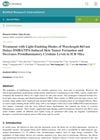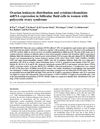Search
forLearn
5 / 5 resultslearn Osteopontin
signaling protein that, when suppressed, may grow hair by reducing inflammation and stem cell loss
learn Neem Oil
natural substance from Neem tree with medicinal and pesticidal properties
learn Procyanidin
bioflavonoid found in plants with antioxidant and hair stimulating properties
learn Alopecia Areata
autoimmune disorder causing patchy hair loss
Research
5 / 1000+ results
research Case Report: Successful Treatment of Alopecia Universalis With Tofacitinib and Increased Cytokine Levels: Normal Therapeutic Reaction or Danger Signal?
Tofacitinib regrew hair in a man with total hair loss but raised cytokine levels, needing more research on possible side effects.

research Treatment with Light-Emitting Diodes of Wavelength 863 nm Delays DMBA/TPA-Induced Skin Tumor Formation and Decreases Proinflammatory Cytokine Levels in ICR Mice
LED light therapy at 863 nm wavelength can slow down skin tumor growth and reduce inflammation in mice.
research The Effects of Methylated Flavonoids on Depression-Like Activity and Pro-Inflammatory Cytokine Thresholds in Mice Induced by Repeated Finasteride Administration
Methylated flavonoids may effectively reduce depression and inflammation caused by finasteride.

research Ovarian Leukocyte Distribution and Cytokine/Chemokine mRNA Expression in Follicular Fluid Cells in Women with Polycystic Ovary Syndrome
Women with PCOS have fewer activated T cells in their ovarian follicles, which might affect fertility.
research The Role of Serum Th1, Th2, and Th17 Cytokines in Patients with Alopecia Areata: Clinical Implications
Alopecia areata severity and treatment response are linked to specific cytokine levels.
Community Join
5 / 28 resultscommunity I bought a microscope, how does my scalp/hairs look? I've been suffering diffuse thinning and hair loss after covid and never recovered (2 yrs ago) I eat healthy, in shape and workout.
A person with hair loss since COVID-19 is considering treatments like finasteride and minoxidil but is hesitant due to potential side effects. Suggestions include visiting a dermatologist, using a ketoconazole shampoo, and considering that post-COVID hair loss might be an autoimmune response.
community My Theory Of Androgenic Alopecia
Hair loss is linked to cellular physiology and the IGF-1 to TGF-B1 ratio, not just androgen sensitivity. The theory lacks evidence, while finasteride and minoxidil are effective treatments.

community Compressed part of research of theory of androgenic/anabolitic balance. AGA h-responders analytic. Theory of physio-metabolitic method of anti AGA treatment
The treatment for androgenetic alopecia involves using finasteride and minoxidil with intense exercise and cold exposure to boost metabolism and reduce androgenic effects, potentially leading to hair regrowth. This approach may activate biological pathways for improved hair and overall health.
community Attempting to assist people with gyno sides on finasteride
Finasteride can cause gynecomastia due to hormonal imbalances. Management includes consulting an endocrinologist and using aromatase inhibitors like anastrozole or supplements like DIM and zinc.
community Comprehensive Microneedling Guide
Microneedling for hair restoration involves daily use of a 0.3 mm device and weekly use of a 0.5 mm device. Combining microneedling with Minoxidil can enhance hair growth.